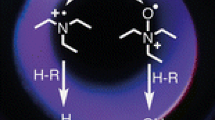Abstract
In an effort to better understand the formation of negative reactant ions in air produced by an atmospheric pressure corona discharge source, the neutral vapors generated by the corona were introduced in varying amounts into the ionization region of an ion mobility spectrometer/mass spectrometer containing a 63Ni ionization source. With no discharge gas the predominant ions were O2 −, however, upon the introduction of low levels of discharge gas the NO2 − ion quickly became the dominant species. As the amount of discharge gas increased the appearance of CO3 − was observed followed by the appearance of NO3 −. At very high levels, NO3 − species became effectively the only ion present and appeared as two peaks in the IMS spectrum, NO3 − and the NO3 −·HNO3 adduct, with separate mobilities. Since explosive compounds typically ionize in the presence of negative reactant ions, the ionization of an explosive, RDX, was examined in order to investigate the ionization properties with these three primary ions. It was found that RDX forms a strong adduct with both NO2 − and NO3 − with reduced mobility values of 1.49 and 1.44 cm2V−1 s−1, respectively. No adduct was observed for RDX with CO3 − although this adduct has been observed with a corona discharge mass spectrometer. It is believed that this adduct, although formed, does not have a sufficiently long lifetime (greater than 10 ms) to be observed in an ion mobility spectrometer.








Similar content being viewed by others
References
Taylor SJ, Piper LJ, Conner JA, FitzGerald J, Adams JH, Harden CS, Shoff DB, Davis DM, Ewing RG (1998) Int J Ion Mobil Spec 1:58
Hill CA, Thomas CLP (2003) The Analyst 128:55
Ross SK, Bell AJ (2002) Int J Mass Spectrom 218:L1
Tabrizchi M, Rouholahnejad F (2004) Rev Sci Instrum 75:4656
Tabrizchi M, Khayamian T et al (2000) Rev Sci Instrum 71:2321
Khayamian T, Tabrizchi M, Jafari MT (2002) Talanta 59:327
Dzidic I, Carroll DI, Stillwell RN, Horning EC (1976) Anal Chem 48:1763
Waltman MJ, Dwivedi P, Blanchard WC, Hill HH Jr, Ewing RG (2008) Talanta 77:249
Skalny JD, Mikoviny T, Matejcik S, Mason NJ (2004) Int J Mass Spectrom 233:317
Skalny JD, Horvath G, Mason NJ (2007) J Optoelectron Adv Mater 9:887
Gravendeel B, de Hoog FJ (1987) J Phys B: At Mol Phys 20:6337
Hobbs PV (2000) Introduction to Atmospheric Chemistry. Cambridge University Press, Cambridge
Brandvold DK, Martinez P (1988) Atmos Environ 22:2477
Brandvold DK, Martinez P, Dogruel D (1989) Atmos Environ 23:1881
Ewing RG, Eiceman GA, Harden CS, Stone JA (2006) Int J Mass Spectrom 255:76
Eiceman GA, Karpas Z (2005) Ion mobility spectrometry, 2nd edn. CRC, Boca Raton
Bowers MT (ed) (1979) Gas phase ion chemistry Vol. 1. Academic, New York
Ewing RG, Atkinson DA, Eiceman GA, Ewing GJ (2001) Talanta 54:515
Acknowledgments
We gratefully acknowledge the Laboratory Directed Research and Development program for funding this research through the Initiative for Explosives Detection at Pacific Northwest National Laboratory. Pacific Northwest National Laboratory is a multiprogram national laboratory operated by Battelle Memorial Institute for the US Department of Energy under Contract DE-AC05-76RL01830.
Author information
Authors and Affiliations
Corresponding author
Rights and permissions
About this article
Cite this article
Ewing, R.G., Waltman, M.J. Mechanisms for negative reactant ion formation in an atmospheric pressure corona discharge. Int. J. Ion Mobil. Spec. 12, 65–72 (2009). https://doi.org/10.1007/s12127-009-0019-8
Received:
Revised:
Accepted:
Published:
Issue Date:
DOI: https://doi.org/10.1007/s12127-009-0019-8



